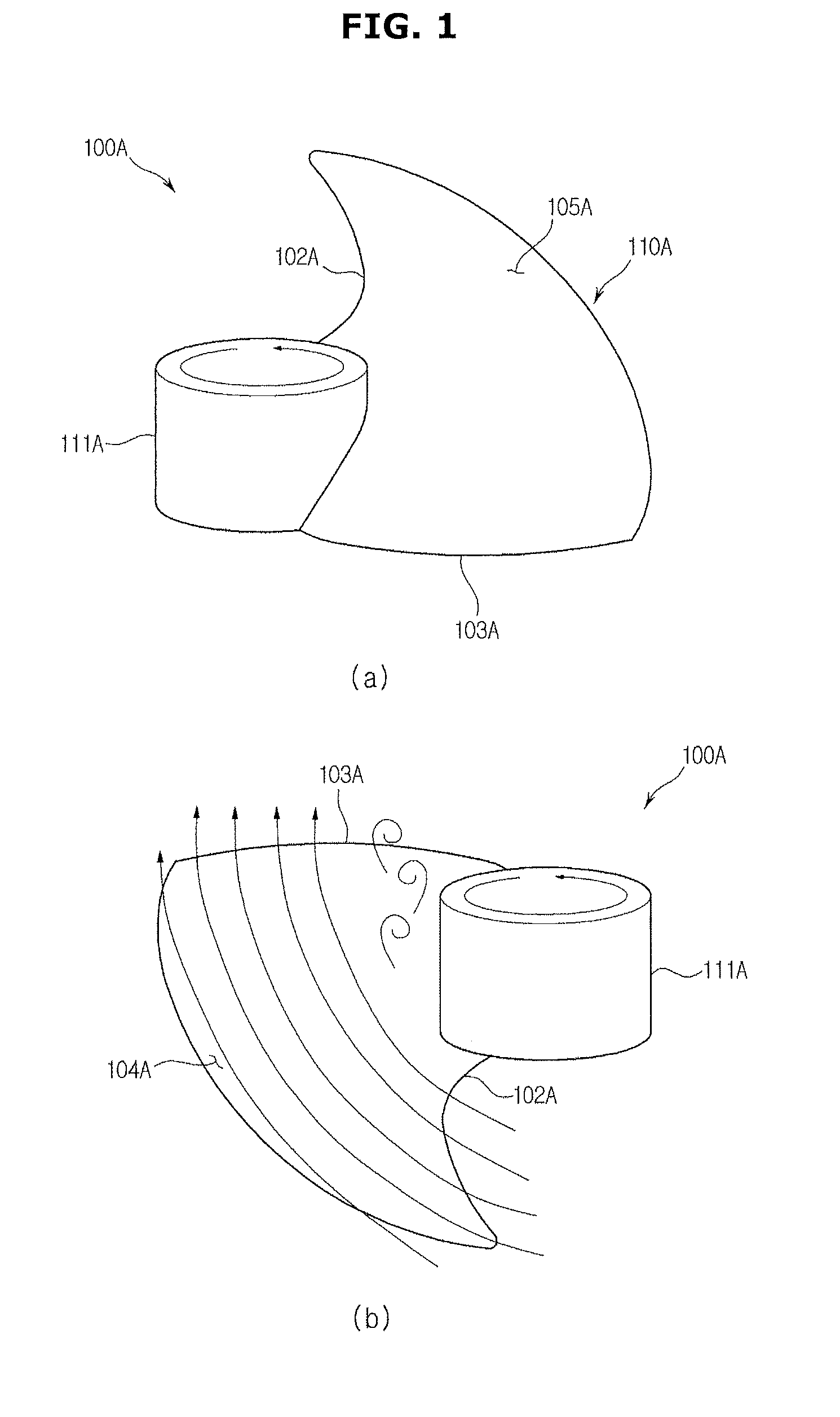Propeller fan
a technology of propeller fans and blades, which is applied in the direction of liquid fuel engines, marine propulsion, and ships. it can solve the problems of reducing the efficiency of pressure efficiency, reducing the efficiency of outflow, so as to improve the power of blades, improve the efficiency of operation, and reduce the effect of heigh
- Summary
- Abstract
- Description
- Claims
- Application Information
AI Technical Summary
Benefits of technology
Problems solved by technology
Method used
Image
Examples
first embodiment
[0081]Hereinafter, the present invention will be described with reference to the drawings.
[0082]A propeller fan 1 of the first embodiment, which is applied, for example, to an outdoor of an air conditioner, includes a plurality of blades 10 radially arranged on the outer circumferential surface of a cylindrical hub 9 and spaced a predetermined distance from each other in a circumferential direction of the hub 9. In each drawing, one of the blades 10 of the propeller fan 1 is shown as a representative example.
[0083]FIG. 3 is a perspective view illustrating the shape of the blade 10 of the propeller fan 1 according to the first embodiment, seen from the side of the suction surface 5, and FIG. 4 shows a cross-section taken along line A-A of FIG. 3 in the longitudinal direction of the blade chord.
[0084]As shown in FIG. 3, the blade 10 is mounted on the lateral surface of the cylindrical hub 9 to form a predetermined spiral extending from one cross section of the hub 9 to the other cross...
second embodiment
[0097]Next, a propeller fan 1 will be described with reference to FIGS. 13 to 16.
[0098]In the second embodiment, as shown in FIG. 13, the recessed portion 6 is open not only on the pressure surface 4 but also on the suction surface 5, and thus a recessed portion 6′ is formed only by lateral portions 61′, in contrast with the first embodiment. In other words, while the first embodiment is provided with the bottom portion 62, the recessed portion 6′ of the second embodiment is provided with an opening 65′ by cutting off the bottom portion 62.
[0099]Hereinafter, a detailed description will be given of the shape of the blade 10 of the second embodiment.
[0100]As shown in FIGS. 13 and 15, the rounded triangular bottom portion 62 of the recessed portion 6′ is cut off. As illustrated in FIG. 14, showing a cross section of the recessed portion 6′ taken along line B-B of FIG. 13, and FIG. 15, showing a cross section of the recessed portion 6′ taken along line D-D of FIG. 13, the recessed port...
third embodiment
[0110]Hereinafter, a third embodiment will be described with reference to the drawings.
[0111]The propeller fan 1 according to the third embodiment, which is applied, for example, to an outdoor of an air conditioner, includes a plurality of blades 10 radially arranged on the outer circumferential surface of a cylindrical hub 9 and spaced a predetermined distance from each other in a circumferential direction of the hub 9. In each drawing, one of the blades 10 of the propeller fan 1 is shown as a representative example.
[0112]The shape of the blade 10 of the propeller fan 1 according to the third embodiment will be described with reference to FIG. 21 showing the perspective view of the blade 10 seen from the side of the suction surface 5, and FIG. 22 showing the pressure surface 4 seen along the axis of rotation of the fan X.
[0113]As shown in FIG. 21, the blade 10 is mounted on the lateral surface of the cylindrical hub 9 to form a predetermined spiral extending from one cross section ...
PUM
 Login to View More
Login to View More Abstract
Description
Claims
Application Information
 Login to View More
Login to View More - R&D
- Intellectual Property
- Life Sciences
- Materials
- Tech Scout
- Unparalleled Data Quality
- Higher Quality Content
- 60% Fewer Hallucinations
Browse by: Latest US Patents, China's latest patents, Technical Efficacy Thesaurus, Application Domain, Technology Topic, Popular Technical Reports.
© 2025 PatSnap. All rights reserved.Legal|Privacy policy|Modern Slavery Act Transparency Statement|Sitemap|About US| Contact US: help@patsnap.com



